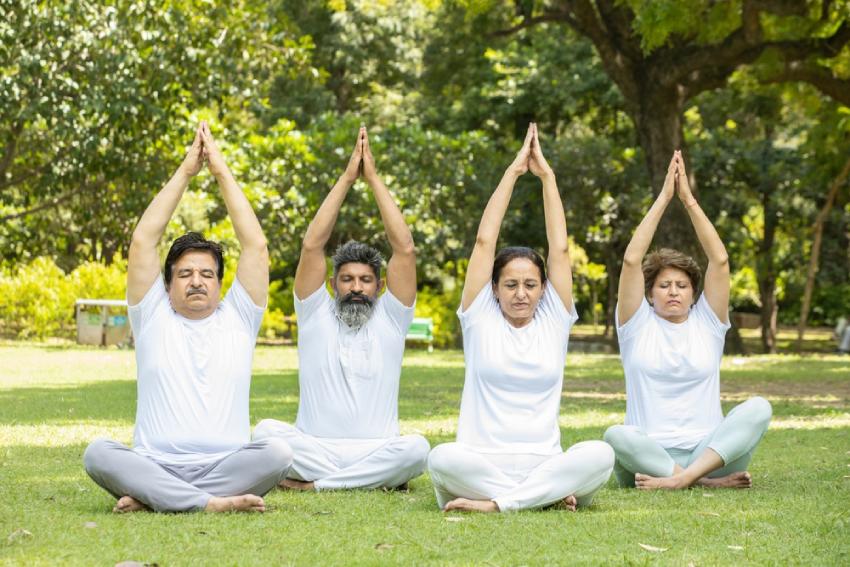
How Ayuryoga Balances Mind, Body, and Spirit
By Nishita Shah
Ayuryoga integrates yoga and Ayurvedic principles to support holistic balance in body, mind, and spirit. This personalized approach nurtures well-being through intentional movement, breath, and lifestyle alignment.
- Personalized practices based on doshas
- Supports physical vitality and flexibility
- Enhances mental clarity and emotional balance
- Encourages spiritual connection and daily rhythm
- Rooted in ancient Indian wellness traditions
In our world, health is often divided into physical, mental, and spiritual categories. In contrast, Ayuryoga offers a refreshing and integrative approach. Rather than treating each layer of being in isolation, this tradition views the human experience as interconnected and inseparable. By weaving together the practices of Ayurveda and yoga, individuals can achive a more complete sense of wellness.
Ayurveda and yoga both originated in ancient India and share a philosophical foundation that prioritizes balance, self-awareness, and alignment with nature. Ayurveda provides a personalized guide to daily routines, diet, and lifestyle based on one’s dosha, or constitution.
Yoga supports physical strength, flexibility, and mental clarity through movement, breathwork, and meditation. Together, these systems form a holistic path to well-being. Ayuryoga is both grounded in tradition and adaptable to modern life.
What Is Ayuryoga ?
Ayuryoga refers to the integration of Ayurvedic principles into a yoga practice. Traditional yoga focuses on movement, breath, and inner awareness. Ayurveda adds a layer of customization that aligns practice with individual needs.
In Ayurveda, each person is viewed as a unique combination of the three doshas: vata, pitta, and kapha. These energies influence everything from digestion and energy levels to mood and sleep patterns.
When yoga is tailored to balance a person’s specific dosha, the practice becomes even more effective.
- A vata-predominant person may benefit from grounding poses, slow breathing, and warming foods.
- Someone with a strong pitta constitution might need cooling postures, calming breathwork, and gentle movement.
- Kapha types, on the other hand, often thrive with more stimulating sequences and energizing activities.
By blending the structural support of yoga with the constitutional insight of Ayurveda, individuals are empowered to maintain equilibrium. It provides the tools they need to find balance throughout the fluctuations of daily life.
Imagine what life could feel like with true balance—body, mind, and spirit.
Is Yoga a Part of Ayurveda?
Yes, yoga is traditionally considered an essential aspect of Ayurvedic living. These sister sciences have been practiced in tandem for centuries, each enhancing the other’s impact.
Ayurveda outlines a comprehensive lifestyle approach that includes diet, herbs, sleep hygiene, and spiritual practices. Within this framework, yoga is prescribed as a daily practice. The goal is to help maintain physical agility, mental clarity, and emotional balance.
The integration is not merely historical. In modern Ayurvedic teachings, yoga is often one of the first recommendations to help support body systems. For example, gentle twisting poses may help maintain digestive fire. Likewise, breath regulation can support mental calm and emotional steadiness.
In this context, yoga is not simply physical exercise. It becomes a vital tool for sustaining the body’s rhythms, processing mental impressions, and nurturing spiritual growth.
Supporting Physical Vitality
One of the most visible benefits of Ayuryoga is physical well-being. By practicing postures suited to your dosha and current state, you may help support the body’s natural systems. This might include:
- Encouraging healthy circulation
- Supporting digestive function
- Maintaining joint mobility and muscle tone
- Promoting restful sleep
Each dosha has different needs. Vata benefits from slow, steady movements that ground the nervous system. Pitta is balanced through cooling, non-competitive sequences. Kapha thrives with energizing postures that stimulate movement and metabolism.
Ayurvedic yoga therapy allows these physical practices to be even more impactful by considering the whole person. It adapts sequences to meet individual needs.

Enhancing Mental Clarity
Mental clarity is one of the most sought-after benefits of any wellness practice. In the context of Ayuryoga, mental wellness is approached through a combination of breathwork, mindful movement, and meditation. These practices help support focus, reduce occasional stress, and promote emotional balance.
Pranayama, or conscious breathing, is especially valuable. Different techniques are used depending on the individual’s constitution. For example:
- Vata types benefit from alternate nostril breathing to support calm and focus
- Pitta types may use cooling breath techniques to soothe mental heat
- Kapha types are supported by more stimulating breathwork to promote alertness
Meditation also plays a key role in maintaining mental clarity. Whether it is a few moments of silent sitting or a longer guided visualization, these practices help center attention. They are key to cultivating inner peace.
Combined with Ayurvedic understanding, they become part of a daily rhythm that aligns the mind with natural cycles.
Nourishing the Spirit
While physical and mental wellness are essential, Ayuryoga also addresses the spiritual dimension of life. This is not about adhering to a specific belief system. Instead, it refers to connecting with something greater than the self. That may be nature, community, or a sense of inner purpose.
Daily rituals such as early morning practice, intentional breathing, and mantra chanting help create a container for spiritual growth. These practices encourage presence, gratitude, and inner stillness. Over time, many individuals find that they are more attuned to their intuition. Some feel more resilient in the face of life’s challenges.
Spiritual nourishment through Ayuryoga is not separate from the physical and mental aspects. It is supported by them. When the body feels grounded and the mind is clear, the spirit can more easily shine.
Understanding Ayuryoga Therapy
Ayurvedic yoga therapy is a personalized form of practice. It incorporates elements from both systems to support long-term balance.
This is not a medical treatment or a method for addressing disease. Rather, it is an educational and preventive approach that helps individuals maintain wellness. It accomplishes this by supporting the normal structure and function of the body and mind.
An Ayuryoga therapist may design a personalized plan. Plans include specific asanas, breath techniques, lifestyle habits, and even daily routines. This plan takes into account the individual’s constitution, lifestyle, environment, and current imbalances.
Because it is individualized, yoga therapy is supportive for those seeking to maintain balance in an ever-changing world. It emphasizes self-knowledge, intentional living, and proactive care.
Everyday Ways to Practice Ayuryoga
Incorporating Ayuryoga into your routine does not require major changes. Small, intentional steps can have a big impact. Here are a few ways to begin:
- Start your day with breath awareness and gentle stretching
- Eat meals that are warm, seasonal, and aligned with your constitution
- Observe a regular sleep schedule and unwind with calming postures
- Reflect daily with a short meditation or gratitude practice
These rituals help reset the nervous system, support digestion, and align with natural rhythms. They may seem simple, but their cumulative effect is profound.
Final Thoughts
Ayuryoga is a powerful reminder that well-being is not one-dimensional. By honoring the connection between body, mind, and spirit, this practice invites a more balanced, purposeful way of living. It is not a quick fix or a one-size-fits-all solution. It is a lifestyle that supports each person’s unique path to wholeness.
Reveal your higher self through Panchakarma!
Experience the profound synergy of Ayurveda and yoga with an immersive Panchakarma Retreat at SoHum Mountain Healing Resort. This transformative journey is designed to help you reconnect, realign, and thrive on every level.
SHARE

Nishita Shah
CAP, C-IAYT, E-RYT500
Nishita is passionate about sharing the sciences of Ayurveda and Yoga. She is a program instructor at SoHum and also supports clients with their Panchakarma.